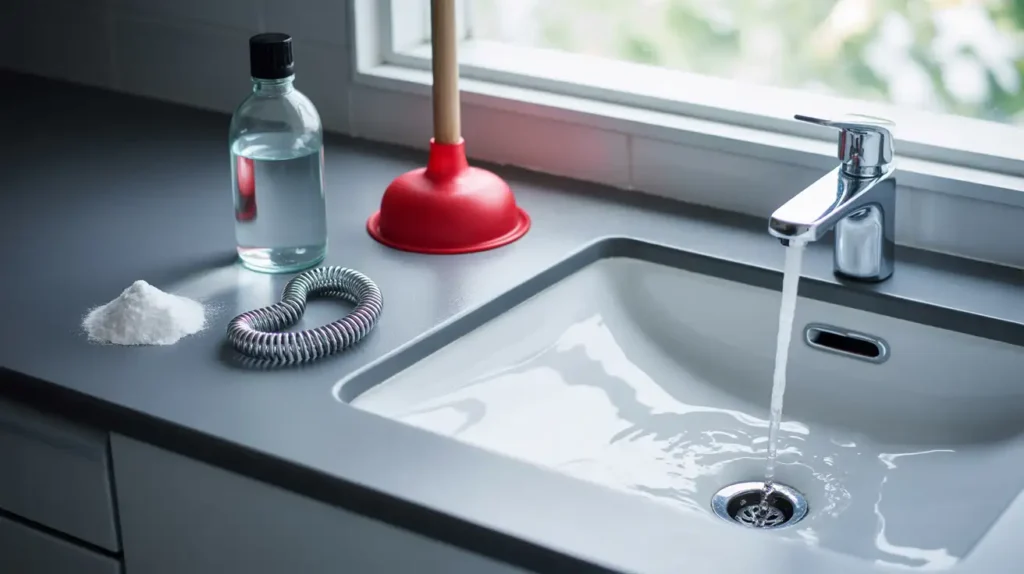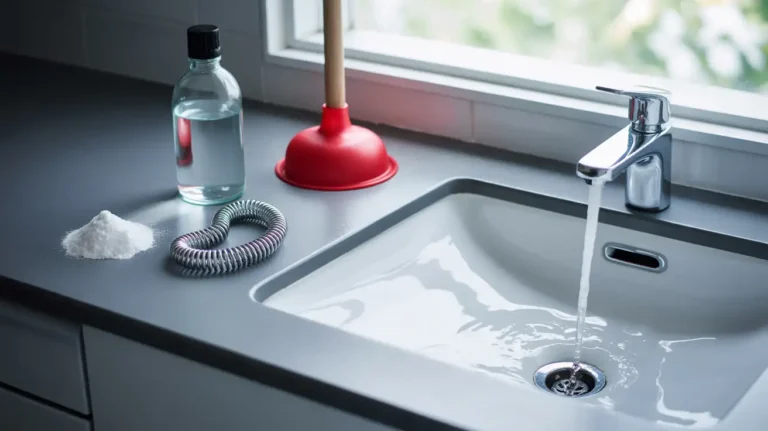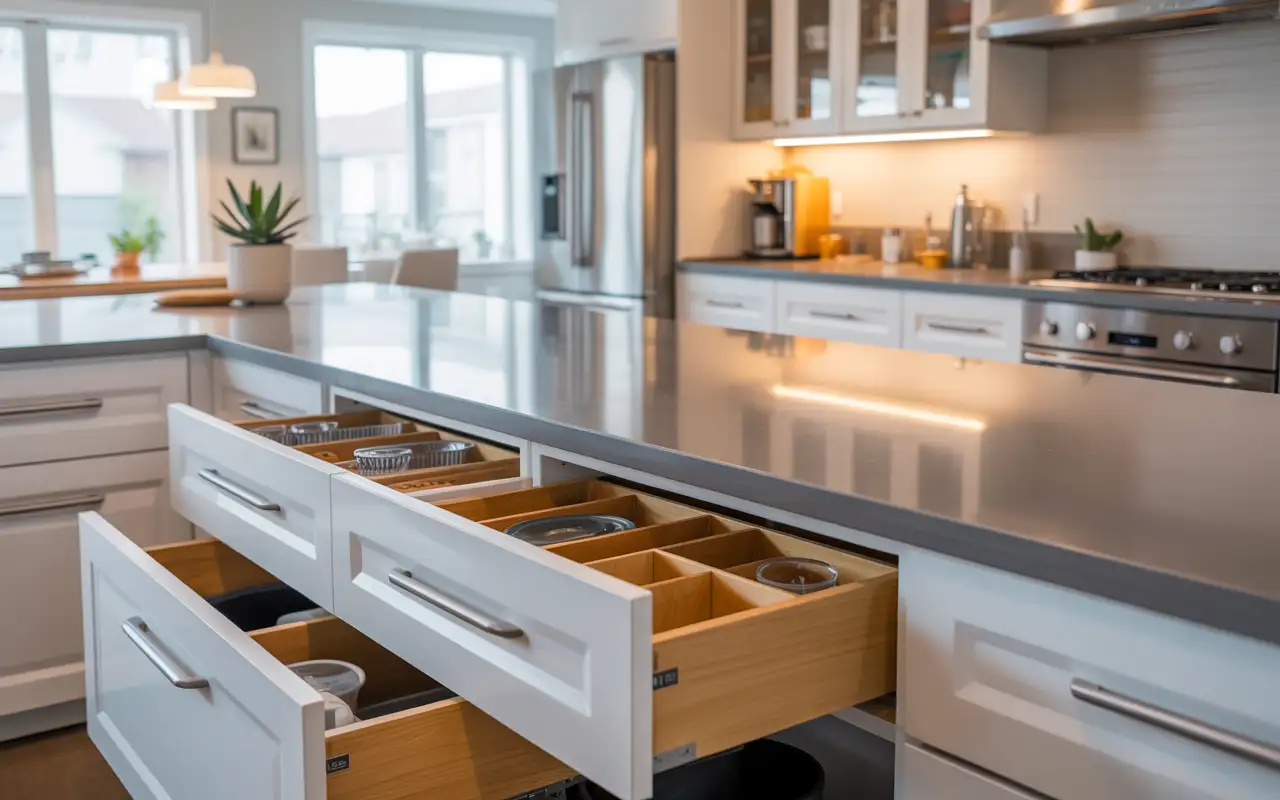Experiencing a slow drain or a clogged lavatory sink is an annoying, yet common, household problem. That standing water is a sign of a sink blockage that needs quick attention. The good news is that you do not need to call a plumber right away.
Learning how to unclog bathroom sink using simple tools and household products can save you hundreds of dollars and clear the drain in minutes. We will show you seven tried-and-tested methods, from easy fixes to advanced disassembly, so you can get your bathroom drain situation fixed fast.
Table of Contents
Why Your Bathroom Sink is Not Draining

To fix a clogged drain, you must first know the enemy. Unlike a kitchen sink, which mainly deals with food scraps and grease, a bathroom sink drain collects a unique blend of materials that form a nasty, stubborn clog.
The typical culprits for a slow running drain are:
- Hair and Debris: This is the primary cause. Strands of hair easily catch onto the drain parts or the drain stopper assembly, creating a net that traps other debris.
- Soap Scum: Bar soap and body wash contain fats that combine with water minerals to form a waxy film. This film coats the inside of the pipes, narrowing the drain and serving as “glue” for the hair.
- Toothpaste and Shaving Cream: These pasty materials add bulk to the hair soap scum mixture, leading to a complete bathroom sink stopped up condition.
When this debris builds up, your wash basin is clogged, and you need a mechanical or chemical reaction to clear the line.
7 Easy Ways to Unclog a Bathroom Sink
Try these methods in order. Start with the simplest option first. If one doesn’t work, move to the next. This saves you time and effort.
Method 1: Remove and Clean the Stopper
Time needed: 5 minutes
Cost: Free
Best for: Hair clogs and slow drains
This is where most clogs actually live. The pop-up stopper catches hair every single day. After a few months, you’ll have a thick mat of hair wrapped around it.
How to do it:
- First, remove your sink stopper. Most stoppers lift straight up when you pull and twist. If yours won’t budge, look under the sink for a horizontal rod connected to the drain pipe. Unscrew the nut holding this rod, slide it out, and the stopper will lift free.
- Look at the stopper. You’ll probably see disgusting hair and slime coating it. Clean it thoroughly with an old toothbrush and bathroom cleaner.
- Now grab a flashlight and look down the drain hole. You’ll see metal crossbars inside. Hair is almost always wrapped around these bars.
- Make a hook from a wire hanger. Straighten the hanger, then bend the last half inch into a small hook shape. Insert this into the drain and rotate it slowly. When you feel resistance, pull up. You’ll extract clumps of hair and debris.
- Repeat this three or four times until nothing more comes out. Flush with hot water for two minutes. Put the stopper back in place.
This simple method clears about 40% of bathroom sink clogs. It works because you’re removing the blockage instead of trying to dissolve it.
Method 2: The Boiling Water Flush
Time needed: 2 minutes
Cost: Free
Best for: Soap scum and grease buildup
Boiling water works well for fresh clogs caused by oils and soap. The extreme heat melts congealed substances that cool tap water can’t touch.
How to do it:
- Boil a full kettle of water until it reaches a rolling boil. Add a quarter cup of dish soap to the water. This acts as a degreaser.
- Remove your sink stopper completely. Pour the boiling water down the drain in one steady, fast stream. Don’t pour slowly or in stages. You want the force and heat to hit the clog all at once.
- Wait 30 seconds. If water drains quickly, you’ve solved the problem. If not, try the next method.
Important: Never use boiling water if you have old plastic pipes. The heat can damage them.
Method 3: Plunger Power
Time needed: 10 minutes
Cost: $5-10 for a small plunger
Best for: Partial clogs and standing water
A plunger creates pressure that pushes and pulls on the blockage. This can dislodge stubborn clogs that other methods miss.
How to do it:
- First, plug the overflow hole near the top of your sink basin. Use a wet rag stuffed tightly into the opening. This step is critical. If you skip it, you won’t create a seal and the plunger won’t work.
- Fill the sink with enough water to cover the drain by two inches. This water helps create a tight seal.
- Place your plunger firmly over the drain opening. Press down slowly to push out any air trapped under the cup. Now plunge vigorously up and down for 15-20 seconds. Use quick, forceful strokes.
- Lift the plunger. If water rushes down, you’ve cleared the clog. If not, repeat two more times. After three attempts, move to the next method if water still won’t drain.
Method 4: Baking Soda and Vinegar
Time needed: 30 minutes
Cost: Under $5
Best for: Light clogs and regular maintenance
This natural method creates a fizzing chemical reaction that can help with minor clogs. However, it’s not as effective as most people think.
How to do it:
- Make sure your sink is completely empty. Pour half a cup of baking soda directly into the drain. Use a funnel if you have one to get all the powder down the hole.
- Pour one cup of white vinegar down the drain. The mixture will fizz and bubble immediately. This is the chemical reaction at work.
- Quickly plug the drain with a stopper or wet towel. This forces the reaction to work on the clog instead of bubbling up into your sink.
- Wait 30 minutes. The fizzing breaks down some organic matter and soap buildup.
- Flush with boiling water for two minutes.
Reality check: This method works for maintenance and very light clogs. It won’t clear a hair clog or severe blockage. Don’t expect miracles from a cup of baking soda and vinegar.
Method 5: Baking Soda and Salt
Time needed: 20 minutes
Cost: Under $3
Best for: Grease and mild soap scum
This combination creates a more aggressive reaction than vinegar alone. The salt acts as a mild abrasive.
How to do it:
- Mix half a cup of baking soda with half a cup of table salt in a bowl. Pour this mixture down your bathroom sink drain.
- Let it sit for 15 minutes. The salt and baking soda work on breaking down organic buildup.
- Boil a kettle of water. Pour the boiling water down the drain in one steady stream.
- Wait two minutes. Test your drain by running tap water. If it drains normally, you’re done. If not, try the next method.
Method 6: Drain Snake or Auger
Time needed: 15 minutes
Cost: $15-25 for a hand-crank snake
Best for: Deep clogs beyond your reach
A drain snake is a long, flexible cable with a hook or spiral tip. It reaches deep into your pipes to grab or break up stubborn clogs.
How to do it:
- Remove your sink stopper first. Feed the snake’s cable into the drain opening. Turn the handle clockwise as you push the cable forward.
- You’ll feel resistance when the snake hits the curve in your P-trap. Keep cranking gently while pushing. The snake will navigate around the bend.
- When you hit firm resistance that doesn’t move, you’ve reached the clog. Crank vigorously for 20-30 seconds. The hook will either break up the blockage or snag it.
- Slowly pull the snake back while continuing to rotate. You’ll likely bring up hair, soap scum, and other nasty stuff.
- Run hot water for three minutes to flush away any remaining debris.
Drain snakes solve about 85% of clogs that other methods can’t reach. They’re worth buying if you deal with frequent blockages.
Method 7: Clean the P-Trap
Time needed: 20 minutes
Cost: Free
Best for: Severe clogs and recurring problems
The P-trap is the curved pipe under your sink. It holds water to block sewer gases from entering your bathroom. It also catches debris and is the most common place for serious clogs.
How to do it:
- Place a bucket directly under the P-trap. This curved pipe sits right below where your drain connects under the sink.
- The P-trap has two slip nuts on each end. These are large plastic or metal rings. Loosen both nuts by turning counterclockwise. Use channel-lock pliers if they’re tight, but try hand-tightening first.
- Carefully lower the P-trap. Water and gunk will spill into your bucket. This is normal and expected.
- Look inside the trap. You’ll see black sludge coating the interior. This is biofilm mixed with hair soap scum and mineral deposits. Scrub it clean using a bottle brush, dish soap, and hot water.
- While the trap is off, look up into the pipe coming from your sink. Also check the pipe going into the wall. Use your flashlight. If you see more buildup or blockages, use your wire hanger or drain snake to clear them.
- Put the P-trap back in place. Tighten both slip nuts by hand. Don’t overtighten with pliers or you might crack plastic threads.
- Turn on your faucet and check for leaks. If water drips, tighten the nuts slightly more.
This method works when everything else fails. It gives you direct access to the most common clog locations.
Using a Wet and Dry Vacuum
Time needed: 10 minutes
Cost: Free if you own one
Best for: Stubborn clogs resistant to other methods
A wet dry vacuum has powerful suction that can pull out blockages. This method works surprisingly well for certain types of clogs.
How to do it:
- Set your vacuum to the liquid setting. Create a tight seal over your drain opening. You can use the vacuum hose directly or wrap a towel around it for a better fit.
- Turn on the vacuum to maximum power. The strong suction may pull the clog free.
- Pulse the vacuum on and off several times. This varying pressure helps dislodge stuck debris.
- Check your vacuum canister. You might see hair and debris that got sucked out.
This method works best for loose clogs. It won’t help with hardened buildup or clogs wrapped around the stopper mechanism.
What NOT to Use: Chemical Drain Cleaners
Many people reach for products like Drano when their bathroom won’t drain. This is a mistake.
Chemical drain cleaners generate intense heat through a chemical reaction. This heat can melt plastic pipes, crack porcelain sinks, and cause severe burns if the liquid splashes.
These products rarely work on hair clogs anyway. They’re designed for grease, not protein. You’ll waste money and potentially damage your plumbing problem.
If you’ve already poured chemical cleaner down your drain and it didn’t work, do not use a plunger. The chemical can splash up and burn your skin or eyes. Wait several hours, flush with cold water, then try mechanical methods.
Tips for Keeping Your Bathroom Sink Clear
Prevention is easier than dealing with a clogged bathroom sink. Follow these simple habits to avoid future blockages.
Weekly Maintenance (30 Seconds)
Remove your stopper once a week. Rinse it under hot water while wiping away visible hair. This simple habit prevents most clogs from forming.
Pull any hair you see sitting on the drain crossbars. Don’t let it accumulate.
Monthly Deep Clean (5 Minutes)
Remove the stopper completely. Use your wire hanger to fish out hair from the drain. Follow with a flush of boiling water mixed with dish soap.
Let the hot water run for two minutes. This helps clear away soap scum before it hardens.
Use a Drain Cover
Install a mesh or silicone drain cover over your sink opening. These catch hair before it enters your pipes. You’ll see exactly how much hair tries to go down your drain every day.
Empty the catch daily. Rinse it weekly. This simple device prevents most hair from causing problems.
Avoid Flushing Certain Items
Never put these down your bathroom sink drain:
- Dental floss (it doesn’t break down)
- Cotton swabs
- Makeup wipes
- Coffee grounds
- Cooking grease
- Hair from brushing
Throw these in the trash instead. They don’t belong in your pipes.
Monthly Enzymatic Treatment
Use a natural enzymatic drain cleaner once a month. These products use bacteria that eat organic matter like hair, soap, and biofilm.
Pour the cleaner into a dry drain at night. Let it work for 8-12 hours. Flush with hot water in the morning.
This prevents buildup from hardening into serious clogs. It’s maintenance, not emergency treatment.
When to Call a Professional Plumber
You have performed the seven best DIY techniques to unclog a sink, and the water still will not drain quickly. This means you likely have a more serious plumbing problem, such as a main sewer line blockage or damaged pipes, requiring a professional.
Service | Estimated National Average Cost (2025 Data) | Why It’s Worth the Cost |
Standard Bathroom Sink Clog | $\$150$ to $\$250$ (Flat Rate) | Quick, professional snaking service, often comes with a warranty. |
Electric Snake/Auger Service | $\$250$ to $\$400$ | Required for tough, deep clogs beyond the P-trap. |
Hydro-Jetting (Main Line Clog) | $\$350$ to $\$600$ | High-pressure water cleaning to clear the entire line. |
The DIY Value: The average homeowner spends over $\$200$ to have a plumber clear a standard bathroom sink clog. Using these DIY steps can save you that money and give you a sense of accomplishment.
Conclusion
A clogged bathroom sink doesn’t require expensive plumber visits in most cases. Start with the simplest methods like removing the stopper and cleaning trapped hair. Move to plunging and drain snakes for tougher blockages. As a last resort, remove your P-trap for direct access to the clog.
Regular maintenance prevents most problems before they start. Spend five minutes each month cleaning your drain and you’ll rarely face a serious clog.
Remember to avoid chemical drain cleaners. They damage pipes and rarely work on hair clogs anyway. Stick with mechanical methods that physically remove blockages.
If you’re planning a complete bathroom upgrade with modern plumbing that drains perfectly, San Diego Home Remodeling offers expert bathroom remodeling services in San Diego. Our team handles everything from drain issues to full renovations. We’ve helped hundreds of homeowners throughout San Diego County create beautiful, functional bathrooms that work flawlessly.
Contact us today for a free consultation on your bathroom project. Let’s discuss how we can transform your bathroom into a space you’ll love for years to come.
FAQs
Can I use a chemical drain opener like Drano or Liquid-Plumr?
We recommend avoiding harsh, chemical-based drain openers. They contain caustic chemicals that can damage older pipes, rubber seals, and septic systems over time. They are rarely effective on tough, physical hair clogs and can pose a safety hazard if you later have to disassemble the P-trap. Stick to natural methods like baking soda and vinegar first.
How can I tell if the clog is a main sewer line issue?
A blockage in the main line affects more than one fixture. If the water in your toilet or shower drain also backs up when you use the bathroom sink, the blockage is likely in the main sewer line. This is the time to skip the DIY and call a plumber for professional snaking or hydro-jetting.
What is the best tool for hair clogs?
While a wire hanger can work in a pinch, the best, low-cost tool is a flexible plastic drain snake or zip-tie tool with barbs. These are specifically designed to hook onto hair clumps and pull them out without damaging the inside of the sink drain.
Does pouring salt and baking soda down the drain really work?
Mixing baking soda and salt with boiling water is a traditional method. It creates a highly abrasive and hot solution that can scour away buildup. It is a good option for a mild slow drain caused by grease or soap, but it is less effective on a solidified hair clog.








